- Published on
Q&A with Alistair Hamish MacDonald
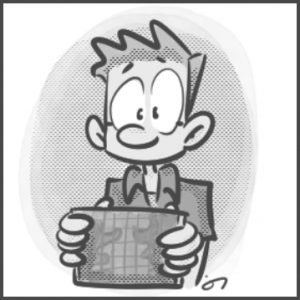
I’m Alistair Hamish MacDonald, a writer and illustrator.
I’ve worked as a copywriter for over a decade, and written four novels, which led me to get into micropress publishing. I’ve got a podcast on iTunes called “DIY Book” which shares everything I learned about doing that. But in the last couple of years, my work has veered almost completely over into cartooning – which was my first love.
How did you get started as visual artist?
I’ve been drawing my whole life, but I have no formal training at all. I’ve just picked up whatever skills I needed to do the work at hand.
When I was little, my best friend Karl had muscular dystrophy, so instead of playing sports (which I didn’t want to do anyway), we stayed inside and drew cartoons. He was the better artist, which spurred me on to improve. Unfortunately, we lost touch when my family moved, and I never heard when he passed away. I think about him and those schooldays a lot now – possibly because of some muscle-memory involved in drawing. (Or maybe that’s just woo-woo thinking.)
We seem to be going through a comix renaissance now, which I’ve lucked into. For a long time, writing felt like a more serious and legitimate thing to do, but in recent years my interests have turned back to cartooning.
One night over a bottle of wine, my client and I had one of those Big Conversations, and the next day I produced a sketchnote of it for him. He thought this was a great way to transmit ideas, so we’ve been doing more and more of that – which has made me really happy. Fiction was always a very difficult row to hoe, but as soon as I switched my focus back to cartooning, the floodgates opened. People instantly ‘get’ the ideas and the joy in the visuals, whereas a novel is so subjective, and such a hard sell.
There’s something weird and wonderful about doing for pay what I did every free moment as a kid, but I’m lucky to have found a patron who’s devoted to using the talents people demonstrate instead of just assigning them jobs.
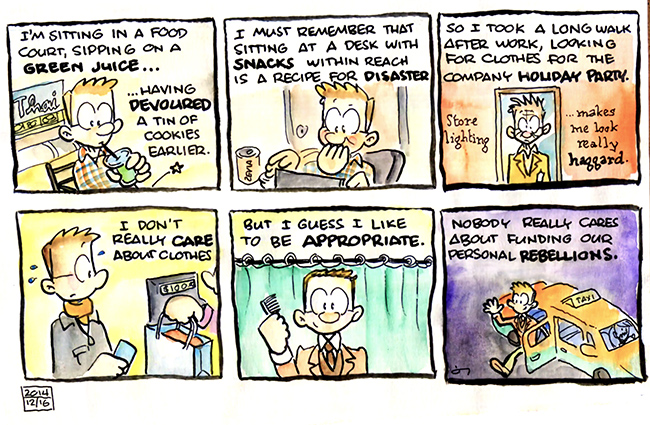
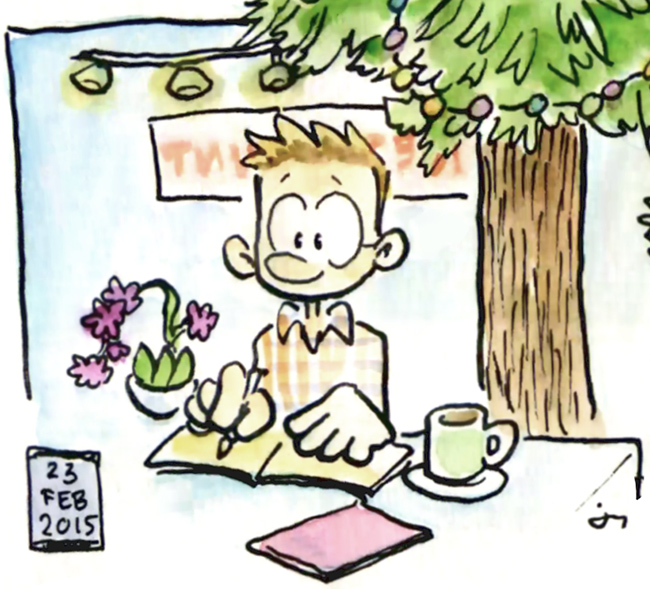
What tools and materials do you use for your work?
My illustration comes in two different forms – paper and screen.
My favourite way to work on paper is in a sketchbook. I love my current book, which I bound using paper from an “artist’s block” I bought at Lidl, a cheap German supermarket. The paper’s thin, but takes ink and washes in a way I can only describe as “delicious”. The problem is that Lidl never has the same things on special twice, so I’ll probably never find this paper again!
The ink I use is Platinum Carbon Black, which is a dark, waterproof ink that’s fine enough to use in fountain pens. I used fineliner pens for years, but fountain pens for drawing have been a great discovery. They keep their shape, and some nibs give a nice line variation. Then, after inking, I add watercolour washes.
My whole setup fits into a messenger bag – which is really my ideal, to have my whole studio wherever I am and be able to do any kind of work.
This is my current setup:
- Kaweco Special 0.7 pencil with non-photo blue lead. (Learning to “under-draw” first in blue pencil has drastically improved my ability.)
- Carbon Desk Pen for fine details. (I sawed mine down, ‘cause it comes the size of a bank-teller pen.)
- Noodler’s Creaper with a flex nib, for outlines.
- Pilot Preppy 0.5 for lettering, Pilot Pet Petit 2 pen for emphasized letters.
- Pilot Petit 2 Fude brush pen for frame borders.
- Kuretake Brush Pen for adding washes.
- Reese watercolours squeezed into a cardboard grid in a teensy cont? tin.
My client work is all digital now, because it just looks so much cleaner, is faster to produce, and (truth be told) the software is so good now that it makes up for my shortcomings as an artist.
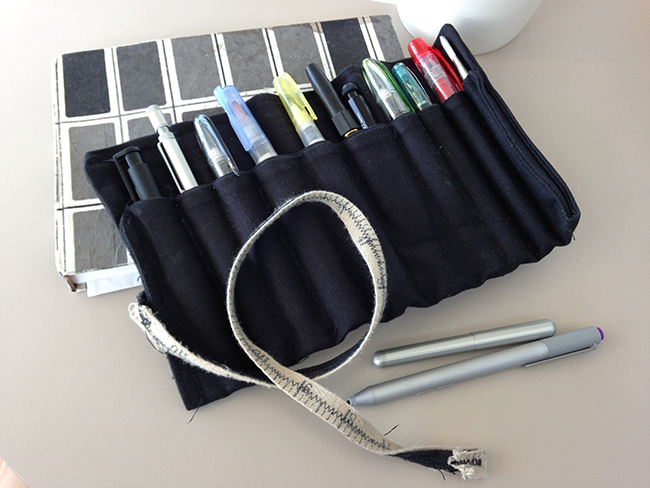

My electronic gear consists of:
- Micosoft Surface Pro 3 – At last, the device I’ve always wanted! It’s a full computer the size of a tablet with proper pen input (no more stupid, bad iPad styluses). I work very small and tight on paper, and the technology still isn’t perfectly accurate, but it’s still pretty great, and has allowed me to finally cross the divide and work directly on-screen.
- Clip Studio Paint (AKA Manga Studio) – This program is a wonder, with all kinds of tools for producing comics (like frame borders and lettering), and its inking and painting engine (I use a third-party set of brushes by “Frenden”) is as subtle and varied as real media. What blows my mind is that all of these tools can be used in either bitmap or vector form. You want to reuse that little spot-drawing on a zeppelin? No problem!
- Dacuda PocketScan – I rough out all my drawings on paper first (starting on screen still feels like going down stairs in roller-skates), then I’d been using a cheap wand scanner to bring them into Manga Studio to ink over, but that involved a lot of faffing about with an SD card. Now I’ve got this wee scanner from a Kickstarter project that sends the image right to the screen over Bluetooth. I still don’t have a jetpack, but this is probably more practical.
What are you working on now?
I’ve just finished the first illustrated book with my client, Dan Sullivan of Strategic Coach. The cartoons in it give a quick visual summary of the ideas in each section and draw people into the text. Dan says he wants to do one of these each quarter for the next 25 years. I’m in!
We did a similar handout for the Abundance 360 Summit with Peter Diamandis, the guy behind the X Prize. It’s exciting to be working with people who are trying to come up with real big-picture advances for humanity – reusable rockets, medical scanners, education devices for remote areas, those kinds of things.
Of course, I’d like to produce some more work of my own, but that’ll go in a the opposite direction – simple little zines and stuff to give away. Admittedly, it’s hard to find the time and energy for that when I’ve just blazed through a tight deadline for work. And it’s tougher to get behind my own ideas.

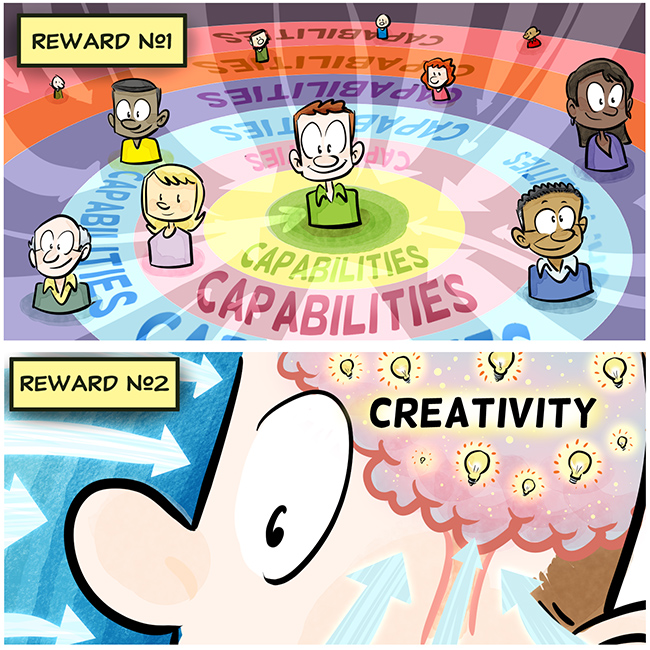
What is your ideal work environment?
A caf? is perfect for me, really. I know people roll their eyes at hipsters with laptops wanting to be seen doing their art in public, but I find that little bit of background noise and activity keeps my monkey-mind occupied, tells it that we’re not missing out on anything, so I’m left alone to get down to work.
I’ve been working from home for years, and I have to say that self-employment feels a lot like mental illness sometimes: It takes a lot of discipline and focus to get things done, no matter how much you love the project (and resistance often increases in direct proportion to importance).
I’ve created all kinds of systems to support myself – including a role-playing game that’s tied into my time-management system. The characters for the various parts of my life “level up” when I’m productive, and their shadow nemeses get more powerful and dangerous when I slack off. Very nerdy, yet fun.
I’m just about to move back to Toronto after living in Scotland since 2001. For the past five years, I’ve been in the far north Highlands, where there really aren’t many places to go and work (just one resto-pub, really). It’s beautiful up here, but I am looking forward to getting back to working directly with others, and exploring the huge comix community that’s developed in Toronto.
Where are your favorite places for art?
I ran around the Toronto Comic Arts Festival last year, which was at once like arriving in Mecca and finding my tribe, yet was completely overwhelming and intimidating, too. I saw so many of my heroes, but didn’t speak to a single one of them.
Whenever I’m in Toronto I’ll drop a bag of money at The Beguiling, or their new TCAF pop-up shop at the Reference Library. Otherwise, I do all my discovery online. I’m subscribed to a zillion RSS feeds that deliver inspiration every day – comic strips, art references, sketchbooks, travel journals, etc.
Who are the illustrators, cartoonists you admire most?
As a kid, I was mad for Charles Schultz’s “Peanuts” and desperate to draw like him. I also went through a weird early period of method acting that I was Mickey Mouse (gloves, rope for a tail, Disney World ears). Otherwise, I didn't read comic books.
I loved the look of Franco-Belgian bandes dessin?es like Tintin, the Smurfs, and Asterix, though my French was so bad I couldn’t read them (still can’t, really). I found the “Spirou” comics in recent years and devoured those. They’re just beautiful, though I don’t really care about the stories, and their racial tropes are shocking to my Canadian sensibilities. (So the “Charlie Hebdo” event elicited a similar mix of reactions from me, too.)
After a long hiatus away from comix and cartooning, I’m now finding lots of people whose work I love for one particular quality or another. It’s great that cartoonists are completely free now to bounce between their own life stories and the fantastical.
Some current favourites are:
- Boulet. His webcomics are just the best, and his use of animated GIFs is breathtaking.
- Dan Berry. His podcast, “Make It Then Tell Everyone” is a brilliant resource for encouragement, perspective, and a feeling of community with other people who do this crazy thing. I met Dan at an indie book fair in London where we both had stalls, and he was using water-brushes ("What are those?!"). I've discovered lots of other tools through his website and podcast, too. It's great fun to hear other people geek out about writing utensils!
- Lynda Barry. I find her thoughts on “the image”, art, and personal writing utterly freeing, focusing, and inspiring. Her book Syllabus is – well, ugly, but full of very important ideas for creative people.
- James Kochalka. I didn’t get American Elf at first glance, but I’m happy I went back to it, because that really taught me how real, personal, and powerful comics can be as an art form. His Cute Manifesto is a touchstone for me, too.
- Dustin Harbin. He doesn't update his blog much, but I love his diary comics, and his lettering is my very favourite.
- Kevin Huizenga. I’ve just discovered him. He's got a lovely, simple style that's informed by a deep philosophical bent.
- Zac Gorman. His diary comics are charmingly honest, and his GIFs are ace, but his greatest strength has always been his connection to, and self-expression about, his subject. I keep trying to remember that that’s what it’s about, what works best about comics, rather than technical ability (cf: James Kolchalka’s “Craft is the Enemy”).
- Lucy Kniseley I find her blend of clear-line illustration, watercolour washes, and probing introspection irresistible.
- Fabrice Tarrin, Jean-Claude Fournier, Yoann Chivard My favourite "Spirou" artists.